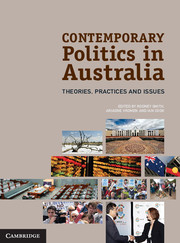Book contents
- Frontmatter
- Contents
- Tables and figures
- Contributors
- Acknowledgements
- Introduction
- I Contemporary Theories of Australian Politics
- Part II Politics in Everyday Australian Life
- Part III Elections
- Introduction to Part III
- 11 Electoral rules
- 12 Political parties as electoral players
- 13 Campaigns and campaign funding
- 14 Voter behaviour
- Part IV Participation and Representation
- Part V Inside the Australian State
- Part VI Contemporary Public Controversies
- Glossary
- References
- Index
- References
11 - Electoral rules
from Part III - Elections
Published online by Cambridge University Press: 05 June 2012
- Frontmatter
- Contents
- Tables and figures
- Contributors
- Acknowledgements
- Introduction
- I Contemporary Theories of Australian Politics
- Part II Politics in Everyday Australian Life
- Part III Elections
- Introduction to Part III
- 11 Electoral rules
- 12 Political parties as electoral players
- 13 Campaigns and campaign funding
- 14 Voter behaviour
- Part IV Participation and Representation
- Part V Inside the Australian State
- Part VI Contemporary Public Controversies
- Glossary
- References
- Index
- References
Summary
Focusing on electoral rules fundamentally is about understanding the institutions in play that structure the electoral behaviour of candidates, parties and voters. Thus Chapter 2 on institutionalism helps us to understand both why these rules are necessary and why they have developed in particular ways. Historical institutionalism and path dependency are important here. The sometimes fierce debate over rules between different parties in parliament can lead to electoral change that either narrows or broadens the opportunities for new electoral competitors. Chapter 1 on democratic theories helps us to understand the principles behind different electoral arrangements, while Chapter 3 suggests ways of studying how and why some of these principles are translated into different electoral rules at federal, state and local levels.
Australia’s electoral laws are fundamental to the nation’s democratic legitimacy. From the electoral laws flow the form and style of representation, the relative strength of political parties, the formation of government and the development of policy positions. In representative democracies, the structure of a state’s electoral laws plays a critical role in determining the nature and form of political discourse and parliamentary representation. The electoral laws establish who can vote and whether people are compelled to vote, how many representatives are to be chosen from which areas, who is in charge of the conduct of elections and how votes are counted. Because adjustment or manipulation of these elements can have severe positive or negative consequences for the viability of political parties, attempts to make changes often are debated fiercely. While Australia has a professional and non-partisan electoral administration, and generally clean and fair elections, this chapter argues that electoral laws are heavily controlled by a Labor and Coalition party cartel.
- Type
- Chapter
- Information
- Contemporary Politics in AustraliaTheories, Practices and Issues, pp. 120 - 131Publisher: Cambridge University PressPrint publication year: 2012



